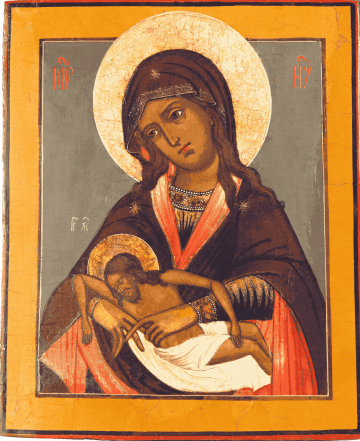Don't Cry Over Me, Mother
(Russia; eighteenth century)
Russia; eighteenth century; 31.1 x 26 cm
Feast: Good Friday
Iconography
The composition is dedicated to the moment when the body of Christ, removed from the cross after death, rested in his mother's arms. This theme is also called “Pieta”, taken from “irmos,” the ninth song of the canon of the Great Saturday: “Weep not for me, O Mother, beholding in the sepulcher the Son whom thou hast conceived without seed in thy womb. For I shall rise and shall be glorified, and as God I shall exalt in everlasting glory those who magnify thee with faith and love.”
The first icons of this type appeared in the sacred art of Byzantium in the thirteenth century and quickly spread in the Balkans. Icons of this type were not so popular in Russia. They appear in the fourteenth – fifteenth centuries but only became widespread in the sixteenth and seventeenth centuries, with Russian artists often being inspired by the compositions of Western masters. This led to the emergence of many icons that differed in their composition, either to a lesser or greater extent from the original Byzantine patterns, which is also evident in this icon.
Under the influence of Western art, unlike the original patterns, the icon Don't Cry Over Me, Mother compositionally changes into the scene of the Pieta, where Christ does not stand supported by Mother who cuddles up to him, but Christ, often proportionately smaller, lies in Mother's arms.
Icon description
The icon depicts the Mother of God holding and gently embracing the body of her dead Son. Christ lies in his mother's arms like a sleeping child, which indicates his diminished body. The Mother of God is also depicted with her hair loose over her shoulders, which is very rare in Eastern iconography. These two symbolisms convey Mary from the moment of the Annunciation, through the childhood of Christ, to His death. They bear witness to the fulfilment of the Law and the Prophets.
The eyes of the Mother of God are directed out of the scene, to humankind. Her gaze carries within itself hope springing from the absolute contemplation of God. Maforion, the mantle of the Blessed Virgin, is of a purple royal colour. It is red on the inside as a sign of blood and boundless love. The chiton, the underwear, is dark blue, with a pearl hem around the neck and on the muffs. The pearls symbolize spiritual purity, the muffs her devotion to the service of the Church.
When the Mother of God is standing under the cross, humanly speaking, she is witnessing the denial of these words. Her Son dies in pain, on the wood of the cross, like a convict who is “despised and rejected by men, A Man of sorrows and acquainted with grief. And we hid, as it were, our faces from Him; He was despised, and we did not esteem Him. Surely He has borne our griefs and carried our sorrows; Yet we esteemed Him stricken, smitten by God, and afflicted. But He was wounded for our transgressions, He was bruised for our iniquities; The chastisement for our peace was upon Him, And by His stripes we are healed.” (Isaiah 53:3-5)
The moment of Mary's suffering, while removing the body of Christ from the cross, is accompanied by devotion: “Behold the maidservant of the Lord! Let it be to me according to your word.” (Luke 1:38) She spoke these words through the same faith with which she accepted what the angel revealed to her at the Annunciation.
What a great and heroic obedience the Mother of God has shown before the “incomprehensible judgments of God!” How unconditionally she “devoted herself to God”, “completely subordinating her reason and will” to Him whose “ways are unfathomable” (cf. Romans 11:33). And at the same time, how powerful is the grace in her soul, how penetrating is the influence of the Holy Spirit, his light and his power!
Through this faith, the Mother of God is perfectly connected with Christ in His humility. Christ, “though he has a divine nature, did not adhere to his equality with God, but renounced himself, took the nature of a servant, became like men”. At Golgotha “he humbled himself and became obedient to death, even to death on the cross.” (cf. Philippians 2:5-8)
The Mother of God shares in the captivating mystery of this humiliation under the cross. It is perhaps the deepest kenosis (κένωσις, emptiness) of faith in human history. The mother feels compassion for her Son at the moment of his death on the cross. Unlike the disciples who dispersed, her faith was much more enlightened. Christ definitively affirmed at Golgotha that He was “a sign to which they would resist,” as the prophet Simeon foretold. At the same time, however, the words addressed to the Mother of God were fulfilled: “yes, a sword will pierce through your own soul also.” (Luke 2:35)
The Mother of God accepts the dead body of her Son with the humility with which she received the message of her motherhood. Her Son is dead now, but this painful moment hides the future joy from His victory. Through suffering, the cross, burial, and resurrection, Christ comes to glory and gives each person the assurance of eternal life. The Apostle Paul writes: “knowing that Christ, having been raised from the dead, dies no more. Death no longer has dominion over Him. For the death that He died, He died to sin once for all; but the life that He lives, He lives to God.” (Romans 6:9-10)
For us, Christ is an invitation to the path of faith to act according to his words: “If anyone desires to come after Me, let him deny himself, and take up his cross, and follow Me.” (Matthew 16:24)


